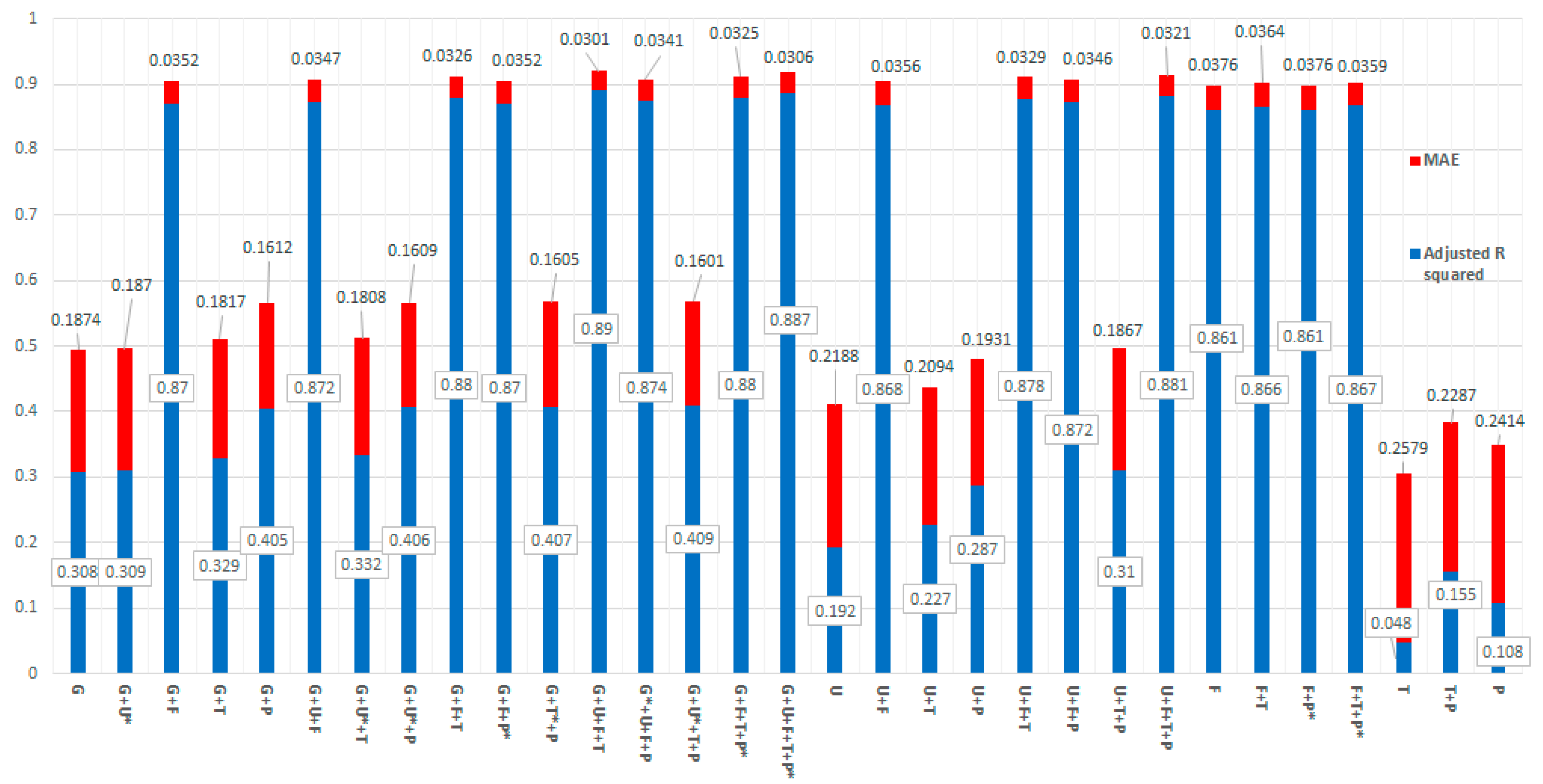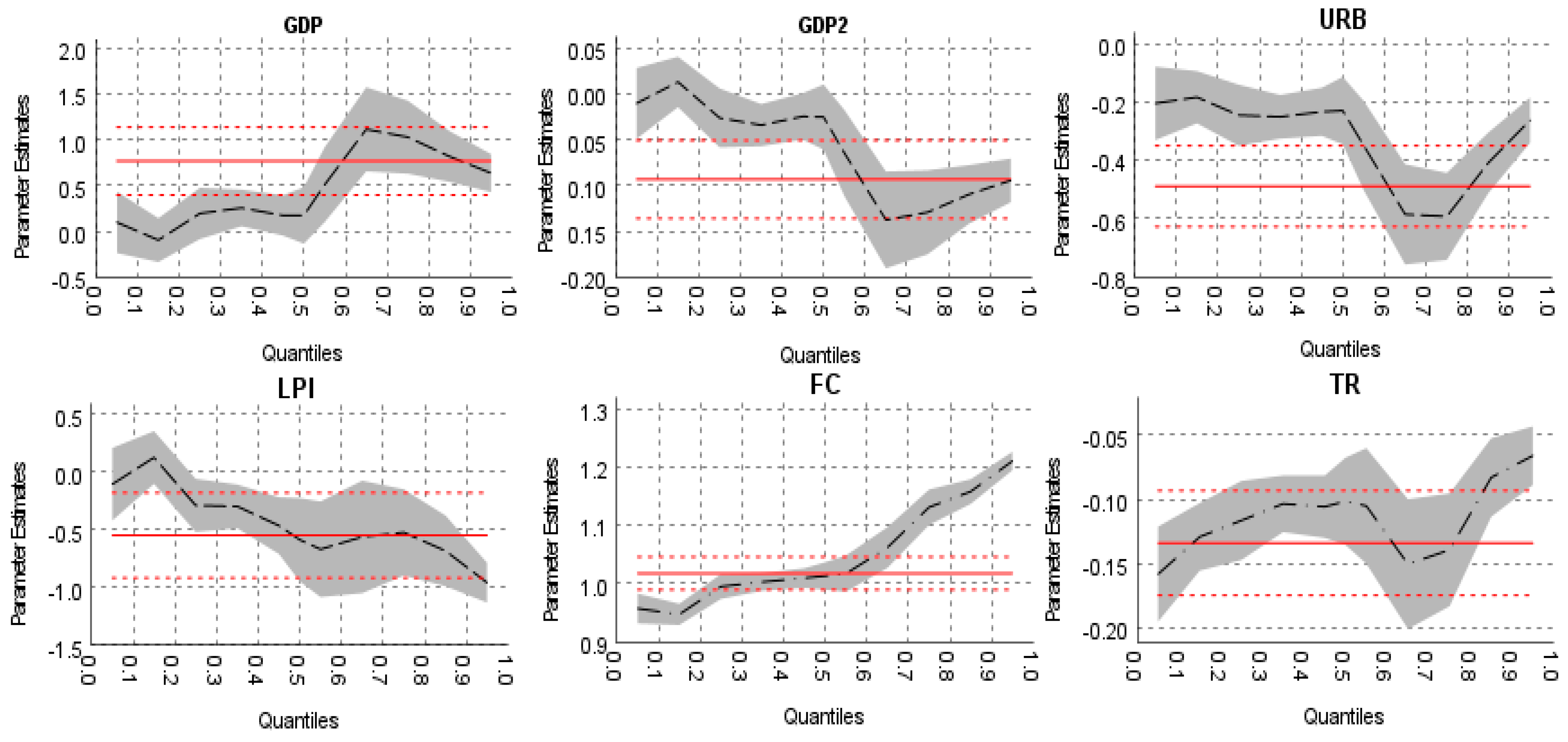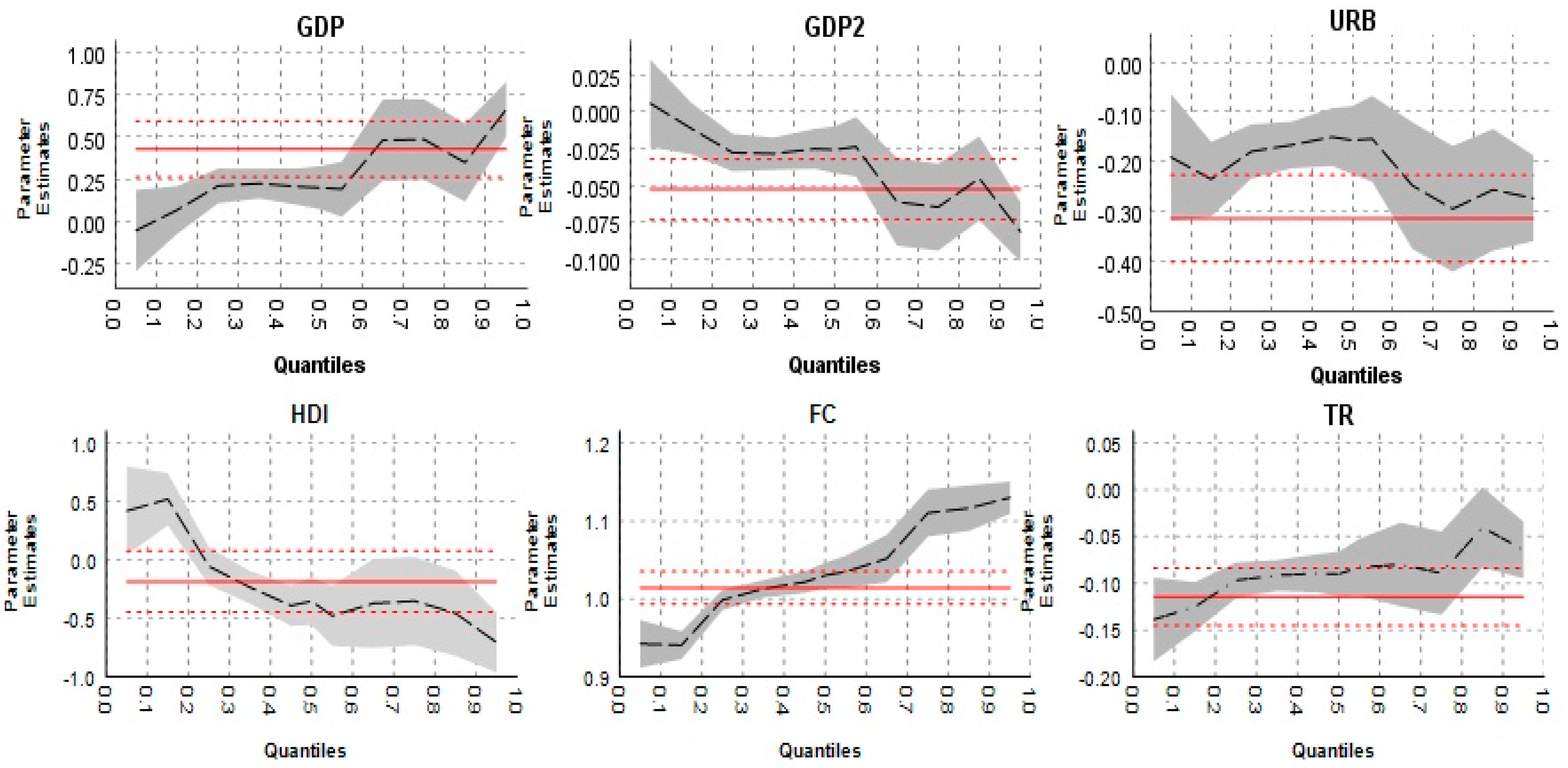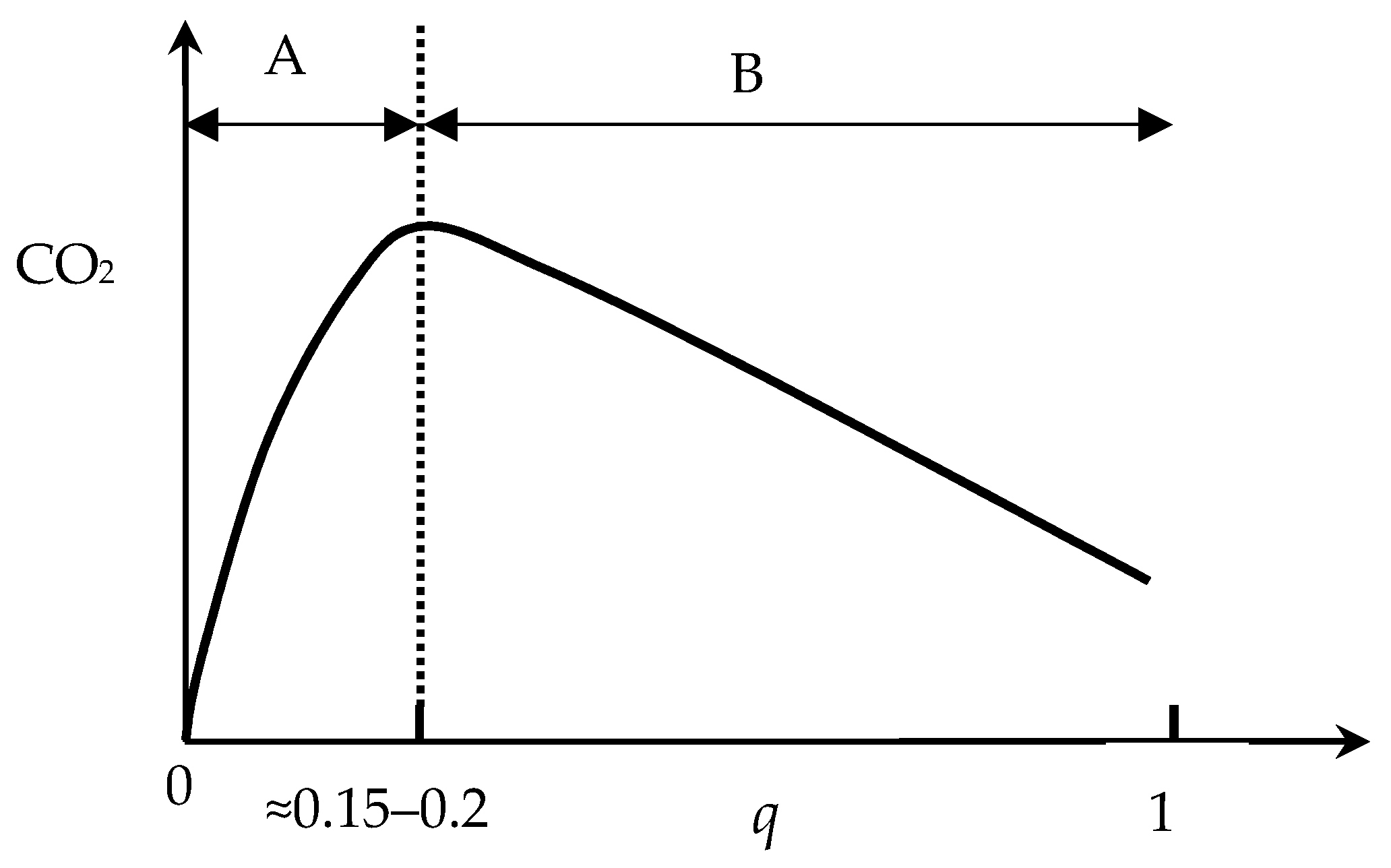Using Quantile Regression to Analyze the Relationship between Socioeconomic Indicators and Carbon Dioxide Emissions in G20 Countries
Abstract
:1. Introduction
2. Materials and Methods
2.1. Data and Variable Selection
2.2. Empirical Model
2.3. Quantile Regression
3. Results and Discussion
3.1. Data Statistics
3.2. Control Variables Selection
3.3. Empirical Analysis
3.4. Discussion
4. Main Conclusions and Policy Implications
Author Contributions
Funding
Institutional Review Board Statement
Informed Consent Statement
Data Availability Statement
Acknowledgments
Conflicts of Interest
Abbreviations
References
- Arguez, A.; Hurley, S.; Inamdar, A.; Mahoney, L.; Sanchez-Lugo, A.; Yang, L. Should We Expect Each Year in the Next Decade (2019–28) to Be Ranked among the Top 10 Warmest Years Globally? Bull. Am. Meteorol. Soc. 2020, 101, E655–E663. [Google Scholar] [CrossRef] [Green Version]
- The Global Risks Report 2020; The World Economic Forum: Geneva, Switzerland, 2020.
- Adoption of the Paris Agreement. Available online: https://unfccc.int/resource/docs/2015/cop21/eng/l09r01.pdf (accessed on 20 March 2021).
- Greenhouse Gas Emissions; United States Environmental Protection Agency: Washington, DC, USA, 2019.
- Mikayilov, J.I.; Galeotti, M.; Hasanov, F.J. The Impact of Economic Growth on CO2 Emissions in Azerbaijan. J. Clean. Prod. 2018, 197, 1558–1572. [Google Scholar] [CrossRef]
- Narayan, P.K.; Saboori, B.; Soleymani, A. Economic Growth and Carbon Emissions. Econ. Model. 2016, 53, 388–397. [Google Scholar] [CrossRef]
- The Legatum Prosperity Index 2020; The Legatum Institute: London, UK, 2020.
- Human Development Index; United Nations Development Programme: New York, NY, USA, 2020.
- Lovins, A.B.; Ürge-Vorsatz, D.; Mundaca, L.; Kammen, D.M.; Glassman, J.W. Recalibrating Climate Prospects. Environ. Res. Lett. 2019, 14, 120201. [Google Scholar] [CrossRef]
- Liu, J.-Y.; Fujimori, S.; Takahashi, K.; Hasegawa, T.; Wu, W.; Geng, Y.; Takakura, J.; Masui, T. The Importance of Socioeconomic Conditions in Mitigating Climate Change Impacts and Achieving Sustainable Development Goals. Environ. Res. Lett. 2020, 16, 014010. [Google Scholar] [CrossRef]
- World Bank. World Development Report 2010: Development and Climate Change; The World Bank: Washington, DC, USA, 2009. [Google Scholar]
- Rogelj, J.; Schleussner, C.-F. Unintentional Unfairness When Applying New Greenhouse Gas Emissions Metrics at Country Level. Environ. Res. Lett. 2019, 14, 114039. [Google Scholar] [CrossRef]
- Zakarya, G.Y.; Mostefa, B.; Abbes, S.M.; Seghir, G.M. Factors Affecting CO2 Emissions in the BRICS Countries: A Panel Data Analysis. Procedia Econ. Financ. 2015, 26, 114–125. [Google Scholar] [CrossRef] [Green Version]
- Grossman, G.; Krueger, A. Environmental Impacts of a North American Free Trade Agreement; National Bureau of Economic Research: Cambridge, MA, USA, 1991; p. w3914. [Google Scholar]
- Panayotou, T. Empirical Tests and Policy Analysis of Environmental Degradation at Different Stages of Economic Development; International Labour Organization: Geneva, Switzerland, 1993. [Google Scholar]
- Kuznets, S. Economic Growth and Income Inequality. Am. Econ. Rev. 1955, 45, 1–28. [Google Scholar]
- Kaika, D.; Zervas, E. The Environmental Kuznets Curve (EKC) Theory. Part B: Critical Issues. Energy Policy 2013, 62, 1403–1411. [Google Scholar] [CrossRef]
- Luo, G.; Weng, J.-H.; Zhang, Q.; Hao, Y. A Reexamination of the Existence of Environmental Kuznets Curve for CO2 Emissions: Evidence from G20 Countries. Nat. Hazards 2017, 85, 1023–1042. [Google Scholar] [CrossRef]
- Grossman, G.M.; Krueger, A.B. Economic Growth and the Environment. Q. J. Econ. 1995, 110, 353–377. [Google Scholar] [CrossRef] [Green Version]
- Narayan, P.K.; Narayan, S. Carbon Dioxide Emissions and Economic Growth: Panel Data Evidence from Developing Countries. Energy Policy 2010, 38, 661–666. [Google Scholar] [CrossRef]
- Arnaut, J.; Lidman, J. Environmental Sustainability and Economic Growth in Greenland: Testing the Environmental Kuznets Curve. Sustainability 2021, 13, 1228. [Google Scholar] [CrossRef]
- Shikwambana, L.; Mhangara, P.; Kganyago, M. Assessing the Relationship between Economic Growth and Emissions Levels in South Africa between 1994 and 2019. Sustainability 2021, 13, 2645. [Google Scholar] [CrossRef]
- Wang, N.; Zhu, H.; Guo, Y.; Peng, C. The Heterogeneous Effect of Democracy, Political Globalization, and Urbanization on PM2.5 Concentrations in G20 Countries: Evidence from Panel Quantile Regression. J. Clean. Prod. 2018, 194, 54–68. [Google Scholar] [CrossRef]
- Awaworyi Churchill, S.; Inekwe, J.; Ivanovski, K.; Smyth, R. The Environmental Kuznets Curve in the OECD: 1870–2014. Energy Econ. 2018, 75, 389–399. [Google Scholar] [CrossRef]
- Chen, J.; Xian, Q.; Zhou, J.; Li, D. Impact of Income Inequality on CO2 Emissions in G20 Countries. J. Environ. Manag. 2020, 271, 110987. [Google Scholar] [CrossRef]
- Lv, Z.; Li, S. How Financial Development Affects CO2 Emissions: A Spatial Econometric Analysis. J. Environ. Manag. 2021, 277, 111397. [Google Scholar] [CrossRef]
- Angel, S.; Lamson-Hall, P.; Blei, A.; Shingade, S.; Kumar, S. Densify and Expand: A Global Analysis of Recent Urban Growth. Sustainability 2021, 13, 3835. [Google Scholar] [CrossRef]
- Maneejuk, N.; Ratchakom, S.; Maneejuk, P.; Yamaka, W. Does the Environmental Kuznets Curve Exist? An International Study. Sustainability 2020, 12, 9117. [Google Scholar] [CrossRef]
- Pata, U.K. The Influence of Coal and Noncarbohydrate Energy Consumption on CO2 Emissions: Revisiting the Environmental Kuznets Curve Hypothesis for Turkey. Energy 2018, 160, 1115–1123. [Google Scholar] [CrossRef]
- Maradana, R.P.; Pradhan, R.P.; Dash, S.; Zaki, D.B.; Gaurav, K.; Jayakumar, M.; Sarangi, A.K. Innovation and Economic Growth in European Economic Area Countries: The Granger Causality Approach. IIMB Manag. Rev. 2019, 31, 268–282. [Google Scholar] [CrossRef]
- Dogan, E.; Turkekul, B. CO2 Emissions, Real Output, Energy Consumption, Trade, Urbanization and Financial Development: Testing the EKC Hypothesis for the USA. Environ. Sci. Pollut. Res. 2016, 23, 1203–1213. [Google Scholar] [CrossRef] [PubMed]
- Ribeiro, H.V.; Rybski, D.; Kropp, J.P. Effects of Changing Population or Density on Urban Carbon Dioxide Emissions. Nat. Commun. 2019, 10, 3204. [Google Scholar] [CrossRef] [PubMed] [Green Version]
- European Commission. Joint Research Centre. Fossil CO2 and GHG Emissions of All World Countries: 2020 Report; Publications Office: Luxembourg, 2020. [Google Scholar]
- World Development Indicators. 2020. Available online: https://datacatalog.worldbank.org/dataset/world-development-indicators (accessed on 20 March 2021).
- Ritchie, H.; Roser, M. Fossil Fuels. Our World Data. 2020. Available online: https://ourworldindata.org/fossil-fuels (accessed on 20 March 2021).
- Wolde-Rufael, Y.; Idowu, S. Income Distribution and CO2 Emission: A Comparative Analysis for China and India. Renew. Sustain. Energy Rev. 2017, 74, 1336–1345. [Google Scholar] [CrossRef]
- Koenker, R.; Bassett, G. Regression Quantiles. Econometrica 1978, 46, 33. [Google Scholar] [CrossRef]
- Buchinsky, M. Estimating the Asymptotic Covariance Matrix for Quantile Regression Models a Monte Carlo Study. J. Econom. 1995, 68, 303–338. [Google Scholar] [CrossRef]
- Lin, B.; Xu, B. Factors Affecting CO2 Emissions in China’s Agriculture Sector: A Quantile Regression. Renew. Sustain. Energy Rev. 2018, 94, 15–27. [Google Scholar] [CrossRef]
- Jardon, A.; Kuik, O.; Tol, R.S.J. Economic Growth and Carbon Dioxide Emissions: An Analysis of Latin America and the Caribbean. Atmósfera 2017, 30, 87–100. [Google Scholar] [CrossRef] [Green Version]
- Hailemariam, A.; Dzhumashev, R.; Shahbaz, M. Carbon Emissions, Income Inequality and Economic Development. Empir. Econ. 2020, 59, 1139–1159. [Google Scholar] [CrossRef]
- Rahman, M.M.; Alam, K. Clean Energy, Population Density, Urbanization and Environmental Pollution Nexus: Evidence from Bangladesh. Renew. Energy 2021, 172, 1063–1072. [Google Scholar] [CrossRef]
- Atsu, F.; Adams, S. Energy Consumption, Finance, and Climate Change: Does Policy Uncertainty Matter? Econ. Anal. Policy 2021, 70, 490–501. [Google Scholar] [CrossRef]
- Chen, F.; Jiang, G.; Kitila, G.M. Trade Openness and CO2 Emissions: The Heterogeneous and Mediating Effects for the Belt and Road Countries. Sustainability 2021, 13, 1958. [Google Scholar] [CrossRef]





| Variable | Description | Unit | Years | Data Source |
|---|---|---|---|---|
| CO2 | CO2 emissions per capita including sources from fossil fuel use and industrial processes | ton CO2/capita | 2000–2019 | [33] |
| LPI | Legatum Prosperity Index | Percentage | 2007–2019 | [7] |
| HDI | Human Development Index | Percentage | 2000–2019 | [8] |
| GDP | GDP per capita expressed in current USD converted by PPP conversion factor | USD/capita | 2000–2019 | [34] |
| FC | Fossil fuel consumption per capita | kWh/capita | 2000–2019 | [35] |
| TR | The sum of exports and imports of goods and services measured as a share of GDP | Percentage of GDP | 2000–2019 | [34] |
| URB | People living in urban areas (% of total population) | Percentage | 2000–2019 | [34] |
| PD | The number of persons per square km | Persons/km2 | 2000–2019 | [34] |
| Variables | CO2 | LPI | HDI | GDP | URB | FC | TR | PD |
|---|---|---|---|---|---|---|---|---|
| Mean | 8.77 | 66.13 | 80.4 | 22209 | 73.1 | 35421 | 52.1 | 139.6 |
| Std. dev. | 5.49 | 10.52 | 10.9 | 17673 | 15.3 | 23887 | 17.6 | 147.5 |
| Median | 8.19 | 60.2 | 83.7 | 15698 | 78.9 | 28709 | 52.1 | 93.3 |
| Skewness | 0.51 | 0.11 | −0.68 | 0.49 | −1.43 | 0.64 | 0.31 | 1.12 |
| Kurtosis | −0.83 | −1.67 | −0.53 | −1.05 | 1.35 | −0.64 | −0.17 | 0.24 |
| Jarque–Bera | 248 *** | 225 *** | 227 *** | 274 *** | 173 *** | 236 *** | 165 *** | 200 *** |
| Observations | 380 | 247 | 380 | 380 | 380 | 380 | 380 | 380 |
| Units | ton CO2/capita | Percentage | Percentage | USD/capita | Percentage | kWh/capita | Percentage of GDP | Persons/km2 |
| Variable | q0.05 | q0.25 | q0.50 | q0.75 | q0.95 |
|---|---|---|---|---|---|
| (Intercept) | −3.066 *** | −3.320 *** | −3.367 *** | −4.481 *** | −4.866 *** |
| (0.000) | (0.000) | (0.000) | (0.000) | (0.000) | |
| GDP | 0.102 | 0.199 * | 0.177 *** | 1.033 *** | 0.640 *** |
| (0.153) | (0.0.064) | (0.002) | (0.000) | (0.000) | |
| GDP2 | −0.010 | −0.026 ** | −0.025 *** | −0.129 *** | −0.094 *** |
| (0.220) | (0.0049) | (0.001) | (0.000) | (0.000) | |
| URB | −0.203 *** | −0.244 *** | −0.228 *** | −0.593 *** | −0.261 *** |
| (0.002) | (0.000) | (0.000) | (0.000) | (0.000) | |
| LPI | −0.102 * | −0.285 *** | −0.583 *** | −0.520 *** | −0.955 *** |
| (0.040) | (0.015) | (0.002) | (0.000) | (0.000) | |
| FC | 0.957 *** | 0.995 *** | 1.013 *** | 1.131 *** | 1.211 *** |
| (0.000) | (0.000) | (0.000) | (0.000) | (0.000) | |
| TR | −0.158 *** | −0.116 *** | −0.101 *** | −0.139 *** | −0.066 *** |
| (0.000) | (0.000) | (0.000) | (0.000) | (0.000) | |
| Observations | 247 | 247 | 247 | 247 | 247 |
| Variable | q0.05 | q0.25 | q0.50 | q0.75 | q0.95 |
|---|---|---|---|---|---|
| (Intercept) | −3.466 *** | −3.390 *** | −2.987 *** | −3.566 *** | −3.462 *** |
| (0.000) | (0.000) | (0.000) | (0.000) | (0.000) | |
| GDP | −0.056 | 0.209 *** | 0.197 *** | 0.485 *** | 0.662 *** |
| (0.247) | (0.000) | (0.003) | (0.000) | (0.000) | |
| GDP2 | 0.006 | −0.028 *** | −0.026 *** | −0.065 *** | −0.082 *** |
| (0.314) | (0.000) | (0.001) | (0.000) | (0.000) | |
| URB | −0.191 *** | −0.180 *** | −0.157 *** | −0.295 *** | −0.274 *** |
| (0.003) | (0.000) | (0.000) | (0.000) | (0.000) | |
| HDI | 0.420 ** | −0.054 *** | −0.353 *** | −0.351 *** | −0.706 *** |
| (0.030) | (0.003) | (0.001) | (0.001) | (0.000) | |
| FC | 0.942 *** | 0.999 *** | 1.030 *** | 1.110 *** | 1.130 *** |
| (0.000) | (0.000) | (0.000) | (0.000) | (0.000) | |
| TR | −0.139 *** | −0.097 *** | −0.090 *** | −0.089 *** | −0.064 *** |
| (0.000) | (0.000) | (0.000) | (0.000) | (0.000) | |
| Observations | 380 | 380 | 380 | 380 | 380 |
Publisher’s Note: MDPI stays neutral with regard to jurisdictional claims in published maps and institutional affiliations. |
© 2021 by the authors. Licensee MDPI, Basel, Switzerland. This article is an open access article distributed under the terms and conditions of the Creative Commons Attribution (CC BY) license (https://creativecommons.org/licenses/by/4.0/).
Share and Cite
Alotaibi, A.A.; Alajlan, N. Using Quantile Regression to Analyze the Relationship between Socioeconomic Indicators and Carbon Dioxide Emissions in G20 Countries. Sustainability 2021, 13, 7011. https://doi.org/10.3390/su13137011
Alotaibi AA, Alajlan N. Using Quantile Regression to Analyze the Relationship between Socioeconomic Indicators and Carbon Dioxide Emissions in G20 Countries. Sustainability. 2021; 13(13):7011. https://doi.org/10.3390/su13137011
Chicago/Turabian StyleAlotaibi, Abdulaziz A., and Naif Alajlan. 2021. "Using Quantile Regression to Analyze the Relationship between Socioeconomic Indicators and Carbon Dioxide Emissions in G20 Countries" Sustainability 13, no. 13: 7011. https://doi.org/10.3390/su13137011
APA StyleAlotaibi, A. A., & Alajlan, N. (2021). Using Quantile Regression to Analyze the Relationship between Socioeconomic Indicators and Carbon Dioxide Emissions in G20 Countries. Sustainability, 13(13), 7011. https://doi.org/10.3390/su13137011






